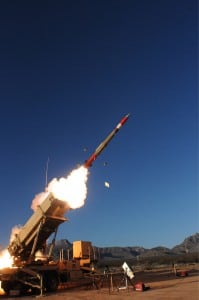The Missile Defense Agency (MDA) and U.S. Army conducted a successful interoperability intercept test of the Terminal High Altitude Area Defense (THAAD) and Patriot missile defense weapon systems on Oct. 1.
The test, called Flight Test Patriot Weapon System (FTP)-27, consisted of one event earlier in the year and another this week, both at the White Sands Missile Range, N.M.

The most recent part entailed having the THAAD Army-Navy/Transportable Radar Surveillance and Control Model 2 (AN/TPY-2) radar detect and track a Black Dagger missile target and provide the data to the Patriot weapon system to determine the launch solution. The Patriot launched a Patriot Advanced Capability-3 (PAC-3) Missile Segment Enhancement (MSE) interceptor that successfully destroyed the target using the THAAD radar data.
In a statement, MDA said that on Feb. 20 the AN/TPY-2 radar also detected and tracked a Black Dagger target and provided the data to the Patriot weapon system, but the missile missed its target “due to an interceptor software upgrade error.”
The agency said that error “has since been corrected, as demonstrated by” the successful intercept.
“The success of FTP-27 validates the interoperability of the Patriot and THAAD weapon systems,” MDA Director Vice Adm. Jon Hill, said in a statement.
“This capability is vital to the Ballistic Missile Defense System to defend against rogue threats to our homeland, deployed forces and allies,” he added.
The test was a joint effort by MDA, U.S. Army Program Executive Office Missiles and Space, and U.S. Army Space and Missile Defense Command (USASMDC).
“We’re proud to support the Missile Defense Agency and U.S. Army Program Executive Office Missiles and Space to provide this vital capability within the Ballistic Missile Defense System,” Scott Arnold, vice president of integrated air and missile defense at Lockheed Martin’s [LMT] Missiles and Fire Control business section, said in a statement.
Lockheed Martin manufactures the THAAD system while Raytheon Technologies [RTX] manufactures the AN/TPY-2 itself. The radar operated in the X-band of the spectrum and operates in either forward-based mode to detect ballistic missiles after launch or in terminal mode to help guide the THAAD interceptors to a target.
MDA also noted the completion of FTP-27 meets the requirements of the 2016 National Defense Authorization Act, requiring the agency and Army to test the interoperability and integration of the THAAD and Patriot systems.
Last year, MDA and the Army conducted the first successful intercept test of THAAD using a government-developed remote launcher kit that extended the range of the defended area, with the radar and interceptor launcher at a distance from each other (Defense Daily, Aug. 30, 2019).
In 2018, MDA and the Army successfully conducted a missile defense tracking exercise demonstrating interoperability between THAAD and Patriot without launching interceptors (Defense Daily, April 10, 2018).
USAMDC spokeswoman Lisa Frye told Defense Daily the Black Dagger is built by the USASMDC Technical Center’s Test Execution Support Division as a ballistic missile target “capable of threat-matching for use in advanced missile defense systems testing.”
The Black Dagger, along with the Sabre Zombie and Pathfinder Zombie targets, are a set of “low-cost targets using government-owned rocket components that have reached the end of their useful life,” Frye continued.
Rather than demilitarize rocket components, the Test Execution Support Division re-purposes the hardware for these kinds of tests.